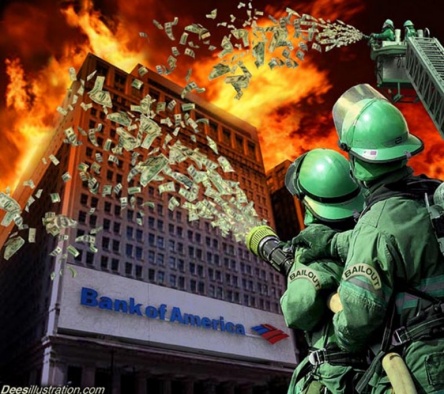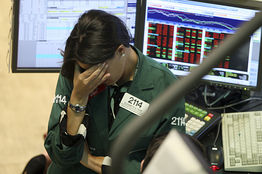Difference between revisions of "Bailout"
m |
m (→"Too big to fail": FA) |
||
| (8 intermediate revisions by 3 users not shown) | |||
| Line 5: | Line 5: | ||
|image_caption=Credit [[The Dees Illustration Studio]] | |image_caption=Credit [[The Dees Illustration Studio]] | ||
|concept=economic | |concept=economic | ||
| − | |constitutes= | + | |constitutes=Financial fraud, Subsidy, Disaster/Preparation |
|so_called=1 | |so_called=1 | ||
|description=A globally organised shift of money from ordinary taxpayers to the already hyper-rich who control the banking and political systems. | |description=A globally organised shift of money from ordinary taxpayers to the already hyper-rich who control the banking and political systems. | ||
|sourcewatch=http://www.sourcewatch.org/index.php/Bailout | |sourcewatch=http://www.sourcewatch.org/index.php/Bailout | ||
}} | }} | ||
| − | + | So-called '''"Bailouts"''' involve inflating the money supply by creating money ''ex nihilo'' and giving it to favoured recipients (typically [[banks]]), sometimes with a few token strings attached. This practice, increasingly common in the 21st century, amounts to covert [[theft]], since such [[inflation]] of the currency decreases the purchasing power of the money of non-recipients. Its coordinated worldwide use prevents clear changes in the exchange rates of currencies and hints at global organisation, presumably at the [[BIS]], although this matter is not publicly acknowledged. | |
==Official narrative== | ==Official narrative== | ||
| Line 16: | Line 16: | ||
=="Too big to fail"== | =="Too big to fail"== | ||
| + | {{FA|Moral Hazard}} | ||
One phrase which crops up is that [[bank]]s are "too big to fail", which might suggest that they were too big. Bailouts however are effectively a huge transfer of wealth ''from'' taxpayers ''to'' those invested in the banks, a policy which ''increases'' the wealth of those banks, which increase wealth inequality. Bailouts are faits accomplis, not subject to even a nominal democratic control or performance review. In this sense they were prefigured by another massive financial fraud, the US [[Savings and loan fraud|Savings and loan]] debacle of the [[1980s]]. | One phrase which crops up is that [[bank]]s are "too big to fail", which might suggest that they were too big. Bailouts however are effectively a huge transfer of wealth ''from'' taxpayers ''to'' those invested in the banks, a policy which ''increases'' the wealth of those banks, which increase wealth inequality. Bailouts are faits accomplis, not subject to even a nominal democratic control or performance review. In this sense they were prefigured by another massive financial fraud, the US [[Savings and loan fraud|Savings and loan]] debacle of the [[1980s]]. | ||
| + | |||
| + | ==Global Financial Crisis of 2008== | ||
| + | {{FA|Global Financial Crisis}} | ||
| + | [[image:Global Financial Crisis.jpg|right|thumb|450px|A trader has a bad day in 2007/8]] | ||
| + | The financial crisis that arose in 2007/08 ended with enormous "bailouts" of "systemically important banks" in addition to "stimulus spending", [[Wikipedia]] notes: "to offset the decline in consumption and lending capacity, avoid a further collapse, encourage lending, restore faith in the integral commercial paper markets, avoid the risk of a deflationary spiral, and provide banks with enough funds to allow customers to make withdrawals." | ||
| + | |||
| + | ==COVID-19== | ||
| + | {{FA|COVID-19}} | ||
| + | After a collapse in the US repo market in Autumn 2019, huge bank bailouts were indicated. These materialised after the official declaration of the [[COVID-19 pandemic]], and continued into 2021. | ||
| + | |||
{{SMWDocs}} | {{SMWDocs}} | ||
| + | ==References== | ||
| + | {{reflist}} | ||
Latest revision as of 05:18, 9 February 2022
(Financial fraud, Subsidy, Disaster/Preparation) | |
|---|---|
 Credit The Dees Illustration Studio | |
| Interest of | George W. Bush |
| A globally organised shift of money from ordinary taxpayers to the already hyper-rich who control the banking and political systems. | |
So-called "Bailouts" involve inflating the money supply by creating money ex nihilo and giving it to favoured recipients (typically banks), sometimes with a few token strings attached. This practice, increasingly common in the 21st century, amounts to covert theft, since such inflation of the currency decreases the purchasing power of the money of non-recipients. Its coordinated worldwide use prevents clear changes in the exchange rates of currencies and hints at global organisation, presumably at the BIS, although this matter is not publicly acknowledged.
Contents
Official narrative
The Official narrative about bailouts is confused and not regularly discussed by commercially-controlled media. When discussing "economic crises", attention is focused on people who lose money (the majority) rather than the tiny minority who gain it. The situation with bailouts is similarly obscure - the story is typically couched with misleading metaphors of existential urgency (e.g. "keeping the economy afloat" etc.) as if banks provide life support to the people. Close discussion about who exactly who decided to bailout which banks to what extent does not figure.
"Too big to fail"
- Full article: Moral Hazard
- Full article: Moral Hazard
One phrase which crops up is that banks are "too big to fail", which might suggest that they were too big. Bailouts however are effectively a huge transfer of wealth from taxpayers to those invested in the banks, a policy which increases the wealth of those banks, which increase wealth inequality. Bailouts are faits accomplis, not subject to even a nominal democratic control or performance review. In this sense they were prefigured by another massive financial fraud, the US Savings and loan debacle of the 1980s.
Global Financial Crisis of 2008
- Full article: Global Financial Crisis
- Full article: Global Financial Crisis
The financial crisis that arose in 2007/08 ended with enormous "bailouts" of "systemically important banks" in addition to "stimulus spending", Wikipedia notes: "to offset the decline in consumption and lending capacity, avoid a further collapse, encourage lending, restore faith in the integral commercial paper markets, avoid the risk of a deflationary spiral, and provide banks with enough funds to allow customers to make withdrawals."
COVID-19
- Full article: COVID-19
- Full article: COVID-19
After a collapse in the US repo market in Autumn 2019, huge bank bailouts were indicated. These materialised after the official declaration of the COVID-19 pandemic, and continued into 2021.
An example
| Page name | Description |
|---|---|
| 2008 Financial Crisis | "an evisceration of some banks by others...a cannibalistic binge billed to the tax-payer"<a href="#cite_note-1">[1]</a> |
Related Document
| Title | Type | Publication date | Author(s) | Description |
|---|---|---|---|---|
| Document:War Martial Law and the Economic Crisis | book extract | 1 November 2010 | Peter Dale Scott |
